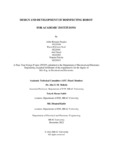| dc.contributor.advisor | Mohsin, Dr. Abu S. M. | |
| dc.contributor.author | Puspita, Afrin Hossain | |
| dc.contributor.author | Saad, Riyan Rahman | |
| dc.contributor.author | Faisal, Asif | |
| dc.contributor.author | Tahsin, Namira | |
| dc.date.accessioned | 2024-01-04T04:10:25Z | |
| dc.date.available | 2024-01-04T04:10:25Z | |
| dc.date.copyright | 2022 | |
| dc.date.issued | 2022-12 | |
| dc.identifier.other | ID: 19221026 | |
| dc.identifier.other | ID: 18221041 | |
| dc.identifier.other | ID: 18221004 | |
| dc.identifier.other | ID: 18221015 | |
| dc.identifier.uri | http://hdl.handle.net/10361/22063 | |
| dc.description | This final year design project is submitted in partial fulfillment of the requirements for the degree of Bachelor of Science in Electrical and Electronic Engineering, 2022. | en_US |
| dc.description | Cataloged from PDF version of final year design project. | |
| dc.description | Includes bibliographical references (pages 153-156). | |
| dc.description.abstract | Cleaning up areas where people assemble is necessary due to the proliferation of several fatal
infections, including the coronavirus. Nowadays, humans perform disinfection procedures in a
variety of settings, which doesn't result in efficient results and may even be harmful to people.
The COVID-19 pandemic has resulted in widespread school closures and an enormous crisis
in education. While the past almost two and a half years have been difficult for all of us,
students were especially impacted by the extended closure of their schools. In light of this, a
technological solution to the issue has been developed to disinfect classrooms using an IoT based UV-C disinfection system. Although the sterilizing properties of the C-band of
ultraviolet (UV) radiation are universally acknowledged, their application has recently become
more important and common due to the Covid-19 outbreak. Usually utilized in a regulated
manner, UV light produces no waste and is environmentally beneficial. Six UV-C lights that
cover the entire system's 360 degrees are linked to the top of the structure in this project. It is
a semi-autonomous device that will be operated by a mobile application and will follow the
necessary safety protocols to shield students from UV ray exposure. The system will have a
limited range for objects and human detection. Moreover, the device will immediately turn off
when humans are detected within a 36-meter range. The method is also capable of identifying
those who exhibit early symptoms of viral assaults. According to the findings, this device
requires 10-15 minutes of UV-LED exposure for any microbe to fully perform its germicidal
functions. | en_US |
| dc.description.statementofresponsibility | Afrin Hossain Puspita | |
| dc.description.statementofresponsibility | Riyan Rahman Saad | |
| dc.description.statementofresponsibility | Asif Faisal | |
| dc.description.statementofresponsibility | Namira Tahsin | |
| dc.format.extent | 170 pages | |
| dc.language.iso | en | en_US |
| dc.publisher | Brac University | en_US |
| dc.rights | Brac University project reports are protected by copyright. They may be viewed from this source for any purpose, but reproduction or distribution in any format is prohibited without written permission. | |
| dc.subject | UV-C disinfecting system | en_US |
| dc.subject | Mobile app | en_US |
| dc.subject | ESP32-Microcontroller | en_US |
| dc.subject | Human detection | en_US |
| dc.subject | Object detection | en_US |
| dc.subject | Temperature detection | en_US |
| dc.subject | RFID (Radio Frequency Identification) | en_US |
| dc.subject.lcsh | Robots. | |
| dc.subject.lcsh | Human-computer interaction. | |
| dc.title | Design and development of disinfecting robot for academic institutions | en_US |
| dc.type | Project report | en_US |
| dc.contributor.department | Department of Electrical and Electronic Engineering, Brac University | |
| dc.description.degree | B. Electrical and Electronic Engineering | |

